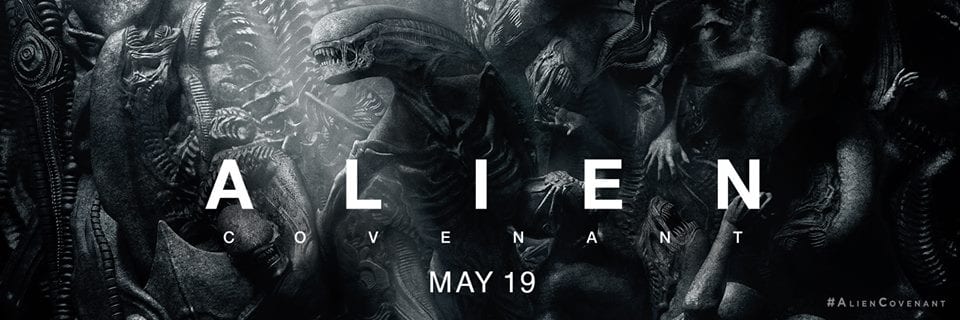“Alien: Covenant” Wins Big with Ridley Scott at the Helm
Cast: Michael Fassbender, Katherine Waterston, Billy Crudup, Danny McBride, Demián Bichir, Carmen Ejogo, Jussie Smollett, Callie Hernandez, Amy Seimetz, Nathaniel Dean, Alexander England, Uli Latukefu, Tess Haubrich, James Franco, Guy Pearce
Director: Ridley Scott
Writers: based on characters created by Dan O’Bannon and Ronald Shusett. Story by Jack Paglen and Michael Green. Screenplay by John Logan and Dante harper.
Length: 2 hrs., 2 mins.

“Alien: Covenant,” which opened May 18th, marks a return to form for Ridley Scott and the “Alien” franchise. I Ridley Scott is The Man in calling the “Alien” shots. This film is about an attempt to colonize a planet known as Origae6. The crew aboard the space ship “Covenant” is carrying 2,000 colonists and 1400 embryos to a friendly planet that has been checked out as habitable and hospitable for potential human colonization.
Unfortunately, an unexpected space mishap does damage to the ship and the troubles start.
Titular captain James Franco, (who is ejected as a corpse into deep space just a few minutes into the movie), doesn’t even make it out of his travel pod, leaving behind his stricken widow, played by female lead Katherine Waterston as Daniels, who takes over for the Naoomi Rapace kick-ass heroine of Ridley Scott’s last “Alien” helming, 2012’s “Prometheus.” This film is set 10 years after “Prometheus” and 18 years before the original “Alien” of 1979. When Franco bites the dust, the second-in-command (Billy Crudup), somewhat cavalierly, I thought, decides the “Covenant” will land, instead, on a planet that rather suddenly crops up on their radar, Planet #4.
“Maybe we need to take a closer look,” says Katherine Waterston as Daniels, who is now second-in-command to Crudup. “Any objections?” She adds that this sudden decision to land on a planet other than their intended target (which is still 7 years away) seems “Too good to be true” and, when Crudup persists in over-ruling her wise counsel, she says, “This is a monumental risk not worth taking.”
Crudup, as new Captain Christopher Orman says, “It’s good judgment based on all the data available,” and Daniels (Watersten) responds, “As your second, I need to protest officially.” (By this point in time, many women in the audience may have been shaking their heads and saying, “Isn’t that just like a man?”)_
I may be one of the few reviewers (still) working who reviewed 1979’s “Alien” with the closing phrase, “It’s grim! It’s gory! It’s horrifying in the best possible way! If this type of movie is for you, you’ll love it!” I even quoted Sally Fields (who won the Oscar that year for “Norma Rae”) who praised the $9.9 million project she had just seen at Cannes as a guest on Johnny Carson’s “Tonight” show, saying, “This piece of celluloid does everything a film should do—-excites you, scares you, interests you.” Television’s “The Flying Nun” lavishing such high praise on what would become the first in a long line (8, so far) of “Alien” spawn was in response to the originality of the concept and how well it was executed, coming just 2 years after “Star Wars” in returning the public’s interest to space adventures. But, while “Star Wars” was often described as a western in space, “Alien” was a horror story in space. And it is certainly true that horror sells well in today’s movie marketplace, so here come the aliens—again.
Today’s “Alien: Covenant,” by contrast with the first 1979 film, cost $110 million to make and employed 15,000 people. It was shot in New Zealand and Australia’s New South Wales and the kick-ass heroine Ripley, originally portrayed by Sigourney Weaver in 1979, was the vanguard of many kick-ass heroines to come. (Homage to Weaver comes in the form of her recorded voice as “Mother.”)
Interestingly enough, I was given a rather comprehensive questionnaire to fill out as I entered the movie this time, asking me, among other things, which of the characters was my favorite. I answered that the monster was my favorite. I smiled when I saw that “Variety” pronounced this as a movie for those who were rooting for more of the alien creature.
I did not stick with the franchise throughout all the non-Ridley Scott films, but I toughed it out through “Alien”(1979), “Aliens” (1986), “Alien: 3” (1992) and “Alien: Resurrection” (1997). Once the sequels devolved into “Alien Versus Predator” (2004) and/or “Alien Versus Predator: Requiem” (2007), with no Ridley Scott in sight, I was out until “Prometheus” (2012), which brought Scott back to the franchise and introduced us to Michael Fassbender as the humanoid robot David. In this film, he plays opposite himself as a new, improved robot identical to David, called Walter.
I first want to say that the trailer that shows David playing the pan flute is, for me (and, I’m thinking, for those who came for the scary), one of the weakest pieces of celluloid that could have been chosen to spread the word that this is a kick-ass film with the highest production values ever and some of the best special effects work seen. (The original “Alien” won an Oscar for visual effects.) Yet, another critic declared it his favorite part of the film, so, to each his own. The clip I’m referring to is the one used on television the night before the film’s May 19, 2017, opening, when Michael Fassbender appeared on James Corden’s late-night show.
Why not show at least one of the alien attacks? To not do so was a bit like showing fans of “The Walking Dead” some quiet, introspective conversational part where the principal characters discuss what direction to go next in their quest to stay alive.
In other words: that clip was boring, and the film is not.
“Alien: Covenant” has taken the scary, creepy parts of the original film and amplified them to the ultimate degree. Like the other new movie out there with a similar theme that leaves us hanging ( and thinking there is going to be a sequel), “Life,” true fans will line up for the next installment, because this film is good and it looks terrific. Despite its over 2-hour length, it keeps you enthralled, living up to Sally Field’s original words of wisdom about the Mother of All “Alien” films..
Others have remarked upon the savvy idea of having the crew members all married to each other, which means that the death of a spouse/character carries more emotional weight. I noticed the ramping up of what true loyalists will remember was the horrifying scene where the alien bursts forth from the first crew member’s body (RIP Ash and Kane), after it had gained access to his body as a host by clamping itself over his face. Will we get some of that? (What do you think?)
I was a bit surprised that Demian Bichir (“The Bridge”), who is brought onboard after intimate contact with the monster, wasn’t quarantined or left behind, because, by now, most of us know the way it works. (Zombies, crew members who have been face-planted by aliens: it’s all the same.) But this is supposedly 10 years prior to the first “Alien,” which then makes you wonder why that intrepid troupe wasn’t more careful around those gigantic pods.
I would also like to say that the same-sex romance between Damien Bichir and Nathaniel Dean was so low-key that I missed it. I didn’t miss the fact that the (onscreen) gay singer from “Empire” (Jessie Smollett) is a crew member, but, since the film has already opened in 34 foreign markets (and taken in $42 million there) and is scheduled to open in 54 more shortly, I may have an explanation as to why those in a position to downplay a same-sex relationship. [I still remember the documentary “Be Like Others” from Iran, and it wasn’t pretty.]
What I did smile at (besides the man, as usual, overruling the woman when it comes to what direction to steer the vehicle) was the way the crew members, upon landing on Planet #4, immediately begin polluting the pristine planet (New Zealand is the stand-in) carrying lit cigars (in a wheat field) and putting out spent cigarettes in the dirt. There is a reason for this, which would give away a plot point; for me, the plot point was that we humans just can’t seem to stop trashing any beautiful planet.
The entire film is very professionally done. I would particularly like to mention the sets and set decoration, courtesy of Chris Seagers (production design) and Victor J. Zolfo, in charge of set decoration. This is a movie that definitely looks like $110 million was spent on it. The use of Wagner’s music and quoting Byron and Shelley also helps class up the project. It is clear that Scott has not abandoned his attempts to discuss mankind’s deepest and most profound questions, (which was primarily what hurt “Prometheus.”) But, regardless of the sheen of deep-thinking, this is a Giant Sci-Fi Horror Adventure Movie, and it is going to make a lot of money.
“Alien: Covenant” has already dislodged “Guardians of the Galaxy 2” atop the money-making charts, and it definitely deserves its first place ranking. While it is true that the monster, originally, was so different and shocking in 1979 that even a pro like Sally Field took to the TV talk show circuit to sing its praises, a concept that is revisited this well deserves to be applauded again.
I’d love to see it on a double bill with “Life,” which was also Top-Notch film-making (Jake Gyllenhaal, Ryan Reynolds) dealing with a similar theme.











